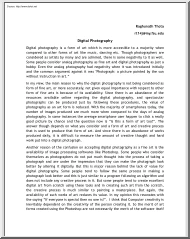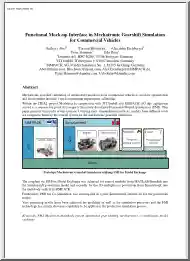Nincs még értékelés. Legyél Te az első!
Mit olvastak a többiek, ha ezzel végeztek?
Tartalmi kivonat
Source: http://www.doksinet Catfish Bass Other Fish at Berryessa Largemouth Bass (Micropterus salmoides) Bullhead Catfish (Ictalurus dolomeiu) Fishing for bass is an exciting experience, and keeping their feeding habits in mind makes finding them much more likely. Size: Largemouth bass – 15 to 20 inches Smallmouth bass – 12 to 18 inches Spotted bass (Micropterus punctulatus) – 12 to 17 inches Difficulty: Because of the technique and skill required to catch these fish and the thrill of hooking a large one, many anglers consider bass to be the ultimate game fish of Lake Berryessa. Where and when: Bass spawn in the spring, when they can be found feeding in shallow areas for most of the day. In the summer, they generally spend their nights resting in deep water, but they move to shallow water to feed in the morning and evening. These areas usually have vegetation or other structures to attract minnows, flies or other small creatures which bass feed on. In addition, these shallow
areas tend to be close to the deep waters where bass rest; therefore, many anglers fish for them along points or steep ridges and the shallow areas along the edge. Fishermen often say that rocky points, floating vegetation, docks or coves filled with trees are prime bass habitat. How to catch them: Every angler seems to have their own belief about the best bass lure. The most popular are floating plugs, spinner baits, rattling lures, plastic worms or a simple live worm or minnow. Catfish are the bottom feeders of Lake Berryessa. Species such as channel catfish, bullhead catfish and white catfish live in the lake. Size: 2-4 lbs on average, but they can grow enormous in deeper parts of the lake, often exceeding 20 lbs Difficulty: Catfish are abundant and easily caught in almost every part of the lake. Where and when: Although catfish feed all day long, they are most active during the night. Waiting until the sun sets will lure the fish into shallow water (10-20 feet). If you do fish for
them during the day, keep in mind that they will be found in deeper water (30 feet or more). How to catch them: To catch catfish, almost all anglers simply sink natural bait to the bottom of the lake, keep the line taut and wait for a bite. The baits most widely used include nightcrawlers, chicken livers, clams, hot dogs or anything with a strong odor. Placing a small bell or bobber at the end of a taut line will alert the angler to a fish strike. Lake Berryessa Get Hooked! Carp (Cyprinus carpio) Another fish which Berryessa supports is the native Sacramento pikeminnow. These large silver fish are actually giant minnows, and they often fool anglers who are pursuing the more popular trout or bass. They are typically considered inedible because of their bony meat, but, like the carp, they put up a strong fight for any angler who hooks them. Fishing Tips and Tricks Sacramento Pikeminnow (Ptychocheilus grandis) White Catfish (Ameiurus catus) Channel Catfish (Ictalurus punctatus)
Smallmouth Bass (Micropterus dolomeiu) Although not generally popular among anglers, Lake Berryessa supports several other types of fish besides the common game fish. The most prevalent of these is the carp, a large orange-colored fish. Originally from Asia, carp are the most widespread introduced fish species in U.S lakes and streams, and they tend to compete with native fish for food and space. Carp can often be seen circling among the weeds in nearly every shallow cove around Berryessa. Although often regarded as inedible by local anglers, carp are considered a delicacy in many cultures, and they put up a thrilling fight when hooked. Berryessa contains a wide variety of minnows, including the golden shiner (Notemigonus crysoleucas) and the threadfin shad (Dorosoma petenense). Lake Berryessa’s waters also support many other species of fresh water organisms including crayfish, clams and otters. U.S Department of the Interior Bureau of Reclamation Mid-Pacific Region Central
California Area Office Source: http://www.doksinet Welcome to Lake Berryessa Lake Berryessa is a popular fishing spot for experienced anglers and beginners alike. This brochure provides information on the species of game fish common in the lake and some useful techniques to find and catch them. Have fun and good luck! Fishing License Information The California Department of Fish and Game requires that all individuals 16 years and older possess a valid fishing license while fishing in any area in California. Annual, one-day and two-day licenses are available. The cost for the license varies from year-to-year, and different prices apply for non-residents. The penalty for being caught without a proper license can be costly, so it is best to always keep your license up to date. Licenses can be purchased in nearby towns or obtained online at http://www.dfgcagov/licensing/ols/ Daily Fishing Limits Fishing is open year-round at Lake Berryessa. Specific daily limits have been set on
certain fish species to ensure that their populations remain stable. These limits fluctuate annually, so please see the current California Freshwater Sport Fishing Regulations (available online at http://www.dfgcagov/regulations/) These limits include both the number of fish that can be caught in one day and the size of the fish that can be removed from the lake. For more information, please contact the Lake Berryessa Visitor Center at 707-966-2111 x 113. Crappie, Bluegill, and Other Sunfish Trout and Salmon Mercury Advisory Due to elevated levels of mercury in Lake Berryessa, as with most lakes in California, caution should be exercised when consuming fish caught here. When ingested in high doses, mercury can cause neurological damage to humans. Eating excessive amounts of fish from any waterway may be harmful. In light of this potential contamination, the Office of Environmental Health Hazard Assessment (OEHHA) has published guidelines for the amount of fish from Lake Berryessa
that should be eaten. A copy of these guidelines is available at the Lake Berryessa Visitor Center. More specific and updated information can be found on OEHHA’s website at http://www.oehhacagov/fishhtml Stop the Spread of Invasive Mussels Invasive quagga and zebra mussels can ruin boats and waterways. These tiny invaders cause a shift in native species and disrupt the ecological balance of entire bodies of water. While Lake Berryessa is not currently known to be infested with quagga or zebra mussels, they could easily be spread here on trailered boats. To keep from spreading invasive species, you must thoroughly clean, drain and dry all parts of your boat between launches into different bodies of fresh water. Expect the possibility of an inspection of your vessel before you are allowed to launch at any of the ramps at Lake Berryessa. More information can be found online at http://www.dfgcagov/quaggamussel Catch and Release If you do not plan to eat the fish you catch, please
consider using barbless hooks and gently returning your catch to the water unharmed. This ensures that fish populations in the lake remain stable and can thrive for many years to come. Black Crappie (Pomoxis nigromaculatus) Chinook Salmon (Onchorhynchus tschawytscha) Bluegill (Lepomis macrochirus) Crappie (pronounced crop-ie), bluegill, red-eared sunfish (Lepomis microlophus) and green sunfish (Lepomis cyanellus) are popular with anglers because of the high daily limits set for them. Rainbow trout, brown trout (Salmo trutta) and brook trout (Salvenlinus fontinalis) are commonly found in Lake Berryessa. Rainbow trout are native to the region and spawn in Upper Putah Creek and Capell Creek during the spring. Chinook salmon and kokanee (Onchorhynchus nerka) have also been introduced to the lake. Size: 2-4 lbs on average but can reach “trophy” sizes of more than 10 lbs Size: Crappie – 1.5 lbs maximum Bluegill and sunfish – less than .5 lbs Difficulty: Open water trolling is
more successful than shore fishing. Time, patience and experience are all necessary to catch these fish. Difficulty: Bluegill and sunfish are ideal beginner fish and are easily caught. Crappie can be hard to find, but once you find a school of them, large catches are common. Where and when: During the spring, trout and salmon swim at depths around 15-20 feet. In the summer, they are generally found below 40 feet. Where and when: Bluegill and sunfish are most prevalent in warm summer months and are easy to find in nearly any shallow cove, weed bed or dock area. Crappie are best caught in the spring under coverings such as docks, vegetation or fallen trees, but they move to deeper water during the summer. How to catch them: These fish are best caught by trolling – dragging a spinner or minnow on a line behind a slow-moving boat in open water – a method made easier with the help of a downrigger or fish finder. Another method is to drift a minnow, nightcrawler or salmon eggs in
open water using a bobber. Shore fishing is possible during the spring months when the water is still cool. Fly fishing is rarely practiced at Lake Berryessa, but it is possible in Upper Putah Creek and is extremely popular in Lower Putah Creek. Check the current California Freshwater Sport Fishing Regulations for seasonal limits in these waterways. How to catch them: Bluegill and sunfish feed on native flies and minnows and are best caught with a bobber and small hook holding a piece of nightcrawler or minnow. For the more elusive crappie, try using a red and white mini-jig or bobber with a minnow. Rainbow Trout (Onchorhynchus mykiss)
areas tend to be close to the deep waters where bass rest; therefore, many anglers fish for them along points or steep ridges and the shallow areas along the edge. Fishermen often say that rocky points, floating vegetation, docks or coves filled with trees are prime bass habitat. How to catch them: Every angler seems to have their own belief about the best bass lure. The most popular are floating plugs, spinner baits, rattling lures, plastic worms or a simple live worm or minnow. Catfish are the bottom feeders of Lake Berryessa. Species such as channel catfish, bullhead catfish and white catfish live in the lake. Size: 2-4 lbs on average, but they can grow enormous in deeper parts of the lake, often exceeding 20 lbs Difficulty: Catfish are abundant and easily caught in almost every part of the lake. Where and when: Although catfish feed all day long, they are most active during the night. Waiting until the sun sets will lure the fish into shallow water (10-20 feet). If you do fish for
them during the day, keep in mind that they will be found in deeper water (30 feet or more). How to catch them: To catch catfish, almost all anglers simply sink natural bait to the bottom of the lake, keep the line taut and wait for a bite. The baits most widely used include nightcrawlers, chicken livers, clams, hot dogs or anything with a strong odor. Placing a small bell or bobber at the end of a taut line will alert the angler to a fish strike. Lake Berryessa Get Hooked! Carp (Cyprinus carpio) Another fish which Berryessa supports is the native Sacramento pikeminnow. These large silver fish are actually giant minnows, and they often fool anglers who are pursuing the more popular trout or bass. They are typically considered inedible because of their bony meat, but, like the carp, they put up a strong fight for any angler who hooks them. Fishing Tips and Tricks Sacramento Pikeminnow (Ptychocheilus grandis) White Catfish (Ameiurus catus) Channel Catfish (Ictalurus punctatus)
Smallmouth Bass (Micropterus dolomeiu) Although not generally popular among anglers, Lake Berryessa supports several other types of fish besides the common game fish. The most prevalent of these is the carp, a large orange-colored fish. Originally from Asia, carp are the most widespread introduced fish species in U.S lakes and streams, and they tend to compete with native fish for food and space. Carp can often be seen circling among the weeds in nearly every shallow cove around Berryessa. Although often regarded as inedible by local anglers, carp are considered a delicacy in many cultures, and they put up a thrilling fight when hooked. Berryessa contains a wide variety of minnows, including the golden shiner (Notemigonus crysoleucas) and the threadfin shad (Dorosoma petenense). Lake Berryessa’s waters also support many other species of fresh water organisms including crayfish, clams and otters. U.S Department of the Interior Bureau of Reclamation Mid-Pacific Region Central
California Area Office Source: http://www.doksinet Welcome to Lake Berryessa Lake Berryessa is a popular fishing spot for experienced anglers and beginners alike. This brochure provides information on the species of game fish common in the lake and some useful techniques to find and catch them. Have fun and good luck! Fishing License Information The California Department of Fish and Game requires that all individuals 16 years and older possess a valid fishing license while fishing in any area in California. Annual, one-day and two-day licenses are available. The cost for the license varies from year-to-year, and different prices apply for non-residents. The penalty for being caught without a proper license can be costly, so it is best to always keep your license up to date. Licenses can be purchased in nearby towns or obtained online at http://www.dfgcagov/licensing/ols/ Daily Fishing Limits Fishing is open year-round at Lake Berryessa. Specific daily limits have been set on
certain fish species to ensure that their populations remain stable. These limits fluctuate annually, so please see the current California Freshwater Sport Fishing Regulations (available online at http://www.dfgcagov/regulations/) These limits include both the number of fish that can be caught in one day and the size of the fish that can be removed from the lake. For more information, please contact the Lake Berryessa Visitor Center at 707-966-2111 x 113. Crappie, Bluegill, and Other Sunfish Trout and Salmon Mercury Advisory Due to elevated levels of mercury in Lake Berryessa, as with most lakes in California, caution should be exercised when consuming fish caught here. When ingested in high doses, mercury can cause neurological damage to humans. Eating excessive amounts of fish from any waterway may be harmful. In light of this potential contamination, the Office of Environmental Health Hazard Assessment (OEHHA) has published guidelines for the amount of fish from Lake Berryessa
that should be eaten. A copy of these guidelines is available at the Lake Berryessa Visitor Center. More specific and updated information can be found on OEHHA’s website at http://www.oehhacagov/fishhtml Stop the Spread of Invasive Mussels Invasive quagga and zebra mussels can ruin boats and waterways. These tiny invaders cause a shift in native species and disrupt the ecological balance of entire bodies of water. While Lake Berryessa is not currently known to be infested with quagga or zebra mussels, they could easily be spread here on trailered boats. To keep from spreading invasive species, you must thoroughly clean, drain and dry all parts of your boat between launches into different bodies of fresh water. Expect the possibility of an inspection of your vessel before you are allowed to launch at any of the ramps at Lake Berryessa. More information can be found online at http://www.dfgcagov/quaggamussel Catch and Release If you do not plan to eat the fish you catch, please
consider using barbless hooks and gently returning your catch to the water unharmed. This ensures that fish populations in the lake remain stable and can thrive for many years to come. Black Crappie (Pomoxis nigromaculatus) Chinook Salmon (Onchorhynchus tschawytscha) Bluegill (Lepomis macrochirus) Crappie (pronounced crop-ie), bluegill, red-eared sunfish (Lepomis microlophus) and green sunfish (Lepomis cyanellus) are popular with anglers because of the high daily limits set for them. Rainbow trout, brown trout (Salmo trutta) and brook trout (Salvenlinus fontinalis) are commonly found in Lake Berryessa. Rainbow trout are native to the region and spawn in Upper Putah Creek and Capell Creek during the spring. Chinook salmon and kokanee (Onchorhynchus nerka) have also been introduced to the lake. Size: 2-4 lbs on average but can reach “trophy” sizes of more than 10 lbs Size: Crappie – 1.5 lbs maximum Bluegill and sunfish – less than .5 lbs Difficulty: Open water trolling is
more successful than shore fishing. Time, patience and experience are all necessary to catch these fish. Difficulty: Bluegill and sunfish are ideal beginner fish and are easily caught. Crappie can be hard to find, but once you find a school of them, large catches are common. Where and when: During the spring, trout and salmon swim at depths around 15-20 feet. In the summer, they are generally found below 40 feet. Where and when: Bluegill and sunfish are most prevalent in warm summer months and are easy to find in nearly any shallow cove, weed bed or dock area. Crappie are best caught in the spring under coverings such as docks, vegetation or fallen trees, but they move to deeper water during the summer. How to catch them: These fish are best caught by trolling – dragging a spinner or minnow on a line behind a slow-moving boat in open water – a method made easier with the help of a downrigger or fish finder. Another method is to drift a minnow, nightcrawler or salmon eggs in
open water using a bobber. Shore fishing is possible during the spring months when the water is still cool. Fly fishing is rarely practiced at Lake Berryessa, but it is possible in Upper Putah Creek and is extremely popular in Lower Putah Creek. Check the current California Freshwater Sport Fishing Regulations for seasonal limits in these waterways. How to catch them: Bluegill and sunfish feed on native flies and minnows and are best caught with a bobber and small hook holding a piece of nightcrawler or minnow. For the more elusive crappie, try using a red and white mini-jig or bobber with a minnow. Rainbow Trout (Onchorhynchus mykiss)




 Ahogy közeledik a történelem érettségi, sokan döbbennek rá, hogy nem készültek fel eléggé az esszéírás feladatra. Módszertani útmutatónkban kitérünk a történet térbeli és időbeli elhelyezésére, a források elemzésére és az eseményeket alakító tényezőkre is.
Ahogy közeledik a történelem érettségi, sokan döbbennek rá, hogy nem készültek fel eléggé az esszéírás feladatra. Módszertani útmutatónkban kitérünk a történet térbeli és időbeli elhelyezésére, a források elemzésére és az eseményeket alakító tényezőkre is.